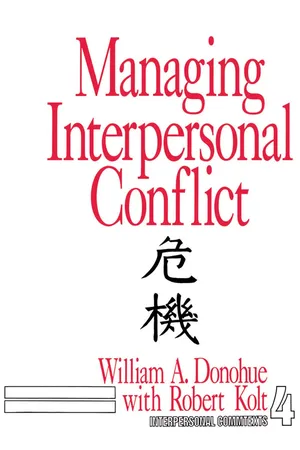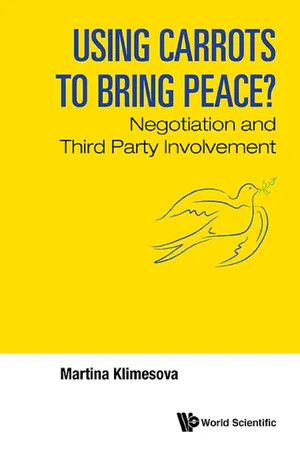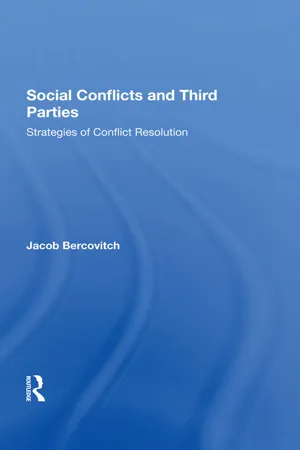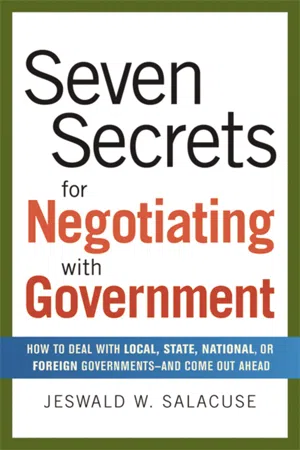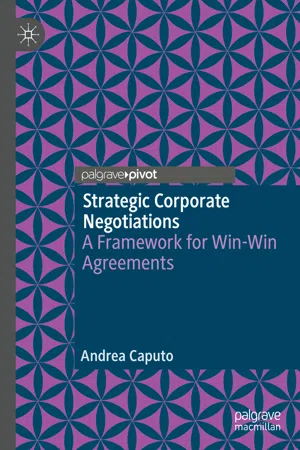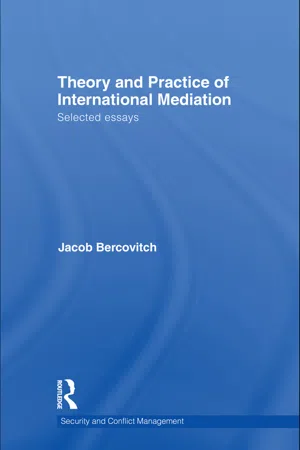Business
Third Party Negotiation
Third party negotiation refers to a process where a neutral party facilitates discussions and agreements between two conflicting parties. This third party, often a professional mediator or arbitrator, helps the involved parties reach a mutually beneficial resolution. By providing an unbiased perspective and guiding the negotiation process, the third party aims to promote fair and effective outcomes.
Written by Perlego with AI-assistance
Related key terms
Related key terms
1 of 4
Related key terms
1 of 3
9 Key excerpts on "Third Party Negotiation"
- eBook - ePub
- William A. Donohue(Author)
- 1992(Publication Date)
- SAGE Publications, Inc(Publisher)
7What Kind of Conflict Help Is Available?
By now, you probably see yourself as a negotiation expert. Actually, negotiation, like all communication contexts, requires extensive experience to realize success. Nevertheless, the basic overview in Chapter 6 should enable you to take control of your negotiation activities.What if your negotiation efforts fail? What if the negotiation regresses to a needs-centered discussion and escalates into verbal, or even physical, aggression? Many people use a third party to help intervene in disputes that escalate out of control. Third parties work best when both disputants agree to use them in a valid attempt at problem solving.Unfortunately, many people reject third-party help. One person in a marriage may want to see a counselor, but the other party refuses. Or a judge might force people to use a third party only to see them sabotage the third party’s efforts.This chapter assumes that both parties want to seek a third party’s help. But which third-party role works best for which kinds of disputes? This chapter provides this information. It focuses on the kinds of help available to people when their negotiation fails. To begin this discussion, it is necessary to define the third-party role.Defining the Third-Party Role
A third party is a neutral individual who enters a conflict with the goal of assisting parties to manage their conflict. This definition is very important because it outlines some basic features of the third-party role. The first feature to consider is neutrality. A third party should approach the conflict as a neutral with no vested interest in the outcome. The third party wishes to side with no one. And the outcome should not personally affect that third party.A judge in a court of law is a third party. And the judge does not personally benefit from his or her decision about a case. The judge applies objective criteria in making a decision about the conflict. In contrast, consider a family conflict, perhaps between a mother and a daughter. If the father steps in the middle, is the father truly neutral? Can the father claim objectivity? In all likelihood, the father’s relationship with both parties compromises neutrality. Both the mother and child might blame the father for the outcome; this blame could personally affect the father’s life. So he finds it difficult to remain neutral and objective. A true third party sustains an objective position at all costs to avoid these kinds of problems. - eBook - ePub
- Robert Nalbandov(Author)
- 2016(Publication Date)
- Routledge(Publisher)
In the first case not only does a third party offer a solution to the conflicting parties but it also enforces it through creation of necessary conditions for its acceptance. This is usually done by a force that the conflicting parties cannot withstand. Third-party further commits itself to keeping the outcome intact and, sometimes, even appoints the winner in the conflict. In doing so, the third party, according to Bloomfield (1995), “… can quite legitimately employ its own resources to bribe or threaten the disputing parties into agreement” 1 or any other outcome. An important aspect of interventions mentioned by Galtung (1965) is that, although the parties may or may not submit to arbitration voluntarily, “in either case they may agree to the solution only if they accept or have to agree”. 2 The guarantee of acceptance of the solution is their bias and self-commitment to pursue its objectives “wholeheartedly”. Even if a conflicting party is dissatisfied with the conflict outcome being imposed by the interveners, third parties will “…establish a hegemon by helping one side to win or by imposing direct rule by outsiders.” 3 1 Bloomfield, D. 1995. Towards Complementarity in Conflict Management: Resolution and Settlement in Northern Ireland. Journal of Peace Research, 32(2), 152–153. 2 Galtung, J. 1965. Institutionalized Conflict Resolution: A Theoretical Paradigm. Journal of Peace Research, 2(4), 360. 3 Snyder, J. and Jarvis, R. 1999. Civil War and the Security Dilemma, in Civil Wars, Insecurity, and Intervention, edited by B. Walter and J. Snyder. New York: Columbia University Press, 27. The other role of a third party is of a neutral and/or impartial mediator with no vested interest in particular outcome of conflict. In the words of Galtung (1965), such interveners may “direct…antagonists towards the mutual acceptance of some point in the compatibility region - eBook - ePub
Working Through Conflict
Strategies for Relationships, Groups, and Organizations
- Joseph P. Folger, Marshall Scott Poole, Randall K. Stutman(Authors)
- 2021(Publication Date)
- Routledge(Publisher)
The third party’s image is under continuous negotiation. Third parties make bids for an image. These bids can be accepted or rejected by the disputants. If the expertise, neutrality, impartiality, or objectivity of the third party is challenged, there can be significant consequences for the intervention (Bernard et al., 1984). In such cases, the relationships between the third party and the disputants shift. Disputants may gain greater control over the interaction process and revert to patterns of interaction that existed prior to the intervention. Studies of mediation, for example, suggest that disputants are more likely to deadlock in sessions in which a mediator loses objectivity and becomes emotionally involved in the process (Donohue, 1989). Alternatively, if impartiality or neutrality is lost, one party may think the intervention is biased against him or her and withdraw from the process.Third parties do not just establish relationships with disputants; they alter relationships between the parties themselves. In particular, third parties influence face-saving between the parties. As discussed in Chapter 6 , disputants are frequently concerned about appearing weak. They can suffer “image loss” if others in the dispute think they will make concessions or crumble easily under pressure. People may act tough and refuse to move from positions they are actually willing to concede, due to fear that giving an inch will mean conceding a mile. Third parties alter this dynamic in an interesting way; they allow movement without altering the relational image the disputants want to preserve.When they move from an intransigent position, disputants can claim that it was the third party who suggested the idea or persuaded them to make the concession. As a result, parties can move without suffering damage to their images: They are not weak, they are simply acting under the guidance or pressure of the third party. Significant strides in breaking impasses can occur when third parties shoulder the responsibility for concessions or unpopular options (Carnevale, 1986; Hiltrop, 1989). Without the third party’s presence, options that the parties are actually willing to accept may not even be explored. - eBook - ePub
Using Carrots To Bring Peace?: Negotiation And Third Party Involvement
Negotiation and Third Party Involvement
- Martina Klimesova(Author)
- 2015(Publication Date)
- WSPC(Publisher)
The term “third party” is broadly conceptualized as an external party with an impact on the negotiating parties. The reason why the term is defined so broadly is so as to be able to address all types of external inducements impacting the negotiation process. The external parties can be further defined based on the role they assume. There is in the current academic discourse no one overruling definition of the different types of external involvement. Hopmann (1996: 228) explains that the main discrepancy lies between mediation and arbitration, when the latter is a procedure during which the third party is asked “to render a judgment about the settlement of the conflict.” Good offices and facilitation may be regarded as a special form of mediation (Ibid.). Mediation, facilitation, and good offices represent types of involvement with different degrees of participation and responsibility in the process itself. In the case of mediation, external actors aim to contribute to the resolving of underlying incompatibilities between the parties (Hopmann, 1996), while the other two are limited to the facilitation of contacts between the adversaries, opening and maintaining channels of communication, and organizing meetings without being involved in discussing actual issues of the conflict. While a mediator is actively involved in agenda-setting and contributes to the discussion of core issues, the facilitator’s involvement is limited to providing good-office services to the adversaries. Facilitators, mediators, and arbitrators represent the most visible group — the first tier — of external actors involved in peace processes. 11 Small states, religious groups, and NGOs (including think tanks and policy centers) represent facilitators with no or very limited material and political leverage - eBook - ePub
Social Conflicts And Third Parties
Strategies Of Conflict Resolution
- Jacob Bercovitch(Author)
- 2019(Publication Date)
- Routledge(Publisher)
Third parties in international conflicts offer proposals and recommendations as a means of influencing perceptions and providing a basis for an agreement. Such proposals can reduce the gap, or narrow the differences, between the parties. They do not, nor can they, pertain to the intellectual and rational process of problem-solving, but to the substantive aspects of an outcome. There may be some debate about the nature and utility of third party’s proposals. There may be circumstances when such proposals are welcome, and circumstances when they are not welcome. There can not, however, be any doubt that third party intervention often takes the form of putting forward proposals and substantive recommendations. The competence of third parties to take an active and directive role in conflict management, to offer solutions and facilitate concessions, and generally provide the critical impetus to a settlement, should be recognized.2. Influence . Third parties can also exert influence on the parties through their judicious exercise of power. The sort of power I have in mind is persuasive rather than coercive. The exercise of third party’s persuasion involves the use of threats (deprivations) and promises (gratifications). Despite basic dissimilarities, both these forms of third party behavior are future-oriented, and both are designed to achieve the same effect, namely, to increase the parties’ motivation to reach an agreement, by changing, or manipulating, their perception of costs and rewards.(18 )The choice of means, and the procedures for transmitting them to the parties, depends upon the resources available to a third party and their importance to the disputants.The evidence from respondents suggests that third parties spend much time trying to persuade disputants to make concessions and that in doing so they are guided by a higher expectation of a settlement. The majority of respondents were of the opinion that:- 1) Mediators should bring pressure on the parties, especially in the later stages of their involvement. They should, however, do so with great care and in a not too obvious way.
- eBook - ePub
Seven Secrets for Negotiating with Government
How to Deal with Local, State, National, or Foreign Governments--and Come Out Ahead
- Jeswald Salacuse(Author)
- 2008(Publication Date)
- AMACOM(Publisher)
How then can you be absolutely sure that a third party will truly act in your interests in a negotiation and not use it in some way to advance its own interests? The short answer to that question is that, of course, you can’t. However, you can increase the chances that a third party will work to get what you want if you spend time on three essential aspects: (1) selection; (2) interest alignment; and (3) monitoring. First, select any third party with care, making sure that it has the range of resources and experience that you need. Second, understand the interests of that third party and how those interests may affect your negotiation. For example, if you form a joint venture with another company to obtain a government contract, evaluate the likelihood that the other company will eventually force you out of the deal and take over the contract itself in the future. Try to develop arrangements that will align that third party’s interest with your own interests. And finally, try to keep an eye on your friends. Monitor what they are doing. This means that you have to stay in contact with them and receive regular reports.Conclusion: Four Rules for Getting a Little Help from Your Friends
Rule #1: The right third party can help you get what you want from a government in a negotiation.Rule #2: Before seeking help, identify the resources you lack in a negotiation and decide who can provide them. Some resources that you need and that a third party can provide include rewards, coercion, expertise and information, relationships, credibility and legitimacy, and alliances and coalitions.Rule #3: When you have identified the friend who can provide what you need, decide on the particular role that you would like that person to play in your negotiation. Possible roles include advisor, support, agent, lobbyist, ally, participant, mediator, and arbitrator.Rule #4: - eBook - ePub
Strategic Corporate Negotiations
A Framework for Win-Win Agreements
- Andrea Caputo(Author)
- 2019(Publication Date)
- Palgrave Pivot(Publisher)
That is negotiation. Negotiations are essential and fundamental for businesses. Improving negotiation skills, as well as increasing the ability to negotiate effectively, is crucial in the managerial, political, and business contexts. It is commonly acknowledged within the literature that negotiation is a process through which two or more parties could reach a needed joint decision while having different preferences (e.g., Fisher et al. 1981 ; Lax and Sebenius 1986 ; Lewicki et al. 2014 ; Pruitt 1981 ; Raiffa et al. 2002 ; Rubin and Brown 1975 ; Zartman 1977). Due to the interdependence, which reigns over and inside multi-actor decision processes (J. D. Thompson 1967), negotiation outcomes are affected by all the decisions made by all the parties involved. It is quite straightforward how, whatever approach we take, the strategy-making process is permeated with a series of negotiations that surround the decisions taken. A negotiation process underlies board meetings where C-level managers take corporate strategic decisions. At the same time, the information brought to the board are the result of a negotiated process where managers strategically decide how to approach the board meetings. Similarly, if we look at any strategy textbook, almost any preparatory activity of analysis to support the strategy-making process can be associated with a negotiation. The same happens when we move the level of analysis to the implementation of strategy. Managers negotiate with each other on how the strategic implementation takes place; they also negotiate at the external of the organization to put the strategy in action, for example, with suppliers, customers, lobbying organizations, and all the stakeholders one can imagine. Given those almost obvious thoughts, everyone with managerial experience would agree that negotiation seems to be left quite aside from strategy literature - eBook - ePub
Theory and Practice of International Mediation
Selected Essays
- Jacob Bercovitch(Author)
- 2011(Publication Date)
- Routledge(Publisher)
We have confirmed the oft-repeated (but until now unverified) notion that mediation will be chosen and employed by states when the conflict is long-drawn-out, intense and complex, and the parties are willing to break their stalemate by cooperating with each other and engaging in some contact and communication (Bercovitch, 1991: 17). When, on the other hand, the conflict structure is simpler and less intense, parties will most likely resolve it themselves through bilateral negotiations. In such circumstances, the parties may perceive third-party intervention as an unwanted intrusion and even resist it.There is at least one caveat to this, however: the results of our study suggest that even if the nature of the dispute is relatively straightforward, negotiation may be impeded by the parties themselves. If they are very different in terms of their capabilities, if one or both of them are fragmented, or if they lack the political will to initiate talks, for example, mediation may then have to be employed.The problem of coping with, or managing, conflicts remains one of the most important challenges confronting all of us. Here we have tried to answer this problem by examining the circumstances under which international actors pursue the strategy of negotiation or mediation. Rather than offer a prescriptive template and suggest that it can be applied to all conflicts, we have tried to examine – theoretically and empirically – the constraints and opportunities of reverting to negotiation or mediation to settle a conflict. We found that a number of contextual factors can affect this choice: moderate levels of conflict, a relatively simple issue structure, homogeneous parties and a willingness to reach a settlement predispose states to use negotiations. High levels of conflict, a complex issue structure, heterogeneous parties and a low motivation to reach an agreement make mediation the more likely strategy. The temptation to suggest a single strategy for all conflicts should be resisted.Note
* Thanks to Wiley-Blackwell Publisher for granting permission for the use of this article from Negotiation Journal , 17, 2001, pp. 59–79.References
Bartos, O. J., 1995. ‘Modeling distributive and integrative negotiations.’ Annals of the American Academy of Political and Social Science - eBook - ePub
Mediation
A Practical Guide
- Alan Stitt(Author)
- 2016(Publication Date)
- Routledge-Cavendish(Publisher)
CHAPTER 3MEDIATION: FACILITATED NEGOTIATION
What is mediation? What magic does it bring to disputants to help them solve a problem that they could not solve themselves? How does it work?Mediation is nothing more and nothing less than facilitated negotiation. The best mediators are experts in the process of negotiation and help disputants overcome obstacles in negotiation. To be an effective advocate in a mediation, a lawyer must be an effective negotiator; to be an effective conflict resolver, a mediator must be an expert negotiator and problem solver.Most negotiators can be placed in one of three categories: competitive bargainers; co-operative bargainers; and principled bargainers.3.1 THE COMPETITIVE BARGAINER
3.1.1 What does the competitive bargainer do?
Competitive bargaining is a common style of negotiating. The competitive or positional bargainer is focused on the outcome of the negotiation, becomes entrenched in positions and does not like to make concessions. When competitive bargainers make concessions, they do so grudgingly. Competitive bargainers use techniques that encourage other negotiators to make concessions, so that these other negotiators will move as close as possible to their bottom lines.The competitive bargainer focuses on the psychology of the other negotiator, trying to out-think the other person in the negotiation, trying to get the other person to make concessions so that the competitive bargainer will reach the best results.The stereotypical competitive bargainer will sometimes do whatever is necessary to achieve a good substantive deal. Some competitive bargainers will bluff, accuse, cheat, intimidate, create false issues, lie or use whatever techniques are necessary to get a good deal.Obviously, there are competitive bargainers who do not fall into the stereotype. These negotiators, while extremely concerned with substantive results, believe that they are doing what is just in the circumstances. They do not consider themselves competitive; they usually define themselves as ‘tough but fair’. They believe that they are skilled at seeing the ‘fair’ outcome, and they will do what they can to move everyone to that outcome. They often believe that others in negotiation are unreasonable and cannot see the obvious and fair solution that is being put forward.
Index pages curate the most relevant extracts from our library of academic textbooks. They’ve been created using an in-house natural language model (NLM), each adding context and meaning to key research topics.
Explore more topic indexes
Explore more topic indexes
1 of 6
Explore more topic indexes
1 of 4
